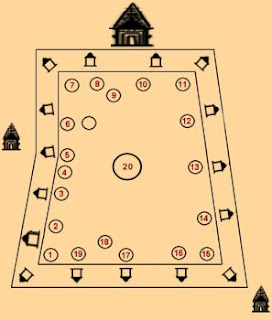 |
| .Mahamaham February 2016. mahamaham2016.in |
 |
| Mahamaham held every 12 years in Kumbakonam,Tamil Nadu. www.alamy.com |
01. This year the Mahamham festival is scheduled for February 22, 2016 - the Mahamaham day. Whereas Masimaham is an annual event that occurs in the Tamil month of Masi (February–March) in the star of Magam, 'Mahamaham' comes once in 12 years. Hence, much importance is given to this rare religious event.
02. It is anticipated that roughly 4.5 million people from various parts of India, SE Asia, etc will visit this temple city during the festival period. They will take a holy dip in the Mahamaham temple tank- an event connected with exoneration of sins.
03. On the 13 th of February, 2016 temple rituals will commence with the ceremonial flag-hoisting in the Shaivite temples followed by Vaishnavite temples, a day later on the 'Ratha Sapthami.'
04. It is a 10 day festival (from February 13th to February 22 nd) and people will be visiting during this period and take holy dip in the tank to wash off their past sins.
05. The Tamil Nadu Government had begun the preparation for this grand festival roughly a year ago. It is expected that the state will bear more than $ 22 million for additional amenities for the visiting devotees such as temporary bus stands at seven locations on the outskirts of the city, adequate drinking water facilities, innumerable medical emergency booths, numerous ambulance vehicles, 72 police booths, monitoring 132 remote cameras located at vantage points, adequate toilet facilities, besides several parking lots each with a capacity to handle 25,000 vehicles on the periphery of the city. In addition to it, more than 1000 fire fighters, paramedics and others will be deployed to take care of the visiting pilgrims. Special care will be taken to face threats from terrorists and other emergency situations.
06. As for the Indian Railways, they will run special shuttle services from near by towns to Kumbakonam to bring in devotees. Further, they have installed 50 to 60 surveillance cameras at the railway station for security reasons and threats. Both the Central and State governments are working hard to make this mammoth festival a grand success and people - friendly. Credit goes to Ms. Jayalalitha, The CM of Tamil Nadu and her ministers , HRCE officials and the Central government staff.
 |
| Thousands bathe .Feb.16, 2014 at Mahamaham tank in Kumbakonam.www.thehindu.com |
08. Taking a holy dip in the Mahamaham tank during the 10 day period is considered as an act of washing off sins committed wittingly or unwittingly in the past; a commitment to lead a pious and sin-free life here-on.
 |
| Mahaamaham-16 mandapams around the tank .www.indian-heritage.org |
10. The inscription in Sanskrit recently discovered by the ASI on the outer wall of the Gharbagraha
 |
| Mahamaham tank, 1892 photo. www.justknow.in |
 |
| rajavedapatasala.org |
11. According to inscription, in 1900s various wells symbolizing Therthams (holy waters) were built
to enable pilgrims to take a holy dip on the Mahamaham day and for this purpose tank water level was kept at low enough to avoid drowning.
12. The inscription in the gopuram (tower) of Nagalpuram, a village in Chengalpattu district, T.N recorded the visit of famous Vijayanagara ruler Sri Krishandevaraya in 1445. It is also recorded in the inscription found in the Shiva temple in Kuthalam town, near Kumbakonam.
Tit-Bits:
a. Sri Govinda Dikshitar was a Kannadiga (native Kannada language speaker) belonging to the Hoysala, Karnataka Brahmin community and lived in a palatial house in Patteeswaram, near Kumbakonam. He was a pious Hindu and a scholar in Sanskrit. Sri Goinda Dikshitar, it is believed, had built the Ramaswamy Temple, Kumbakonam when in 1620, he was the Divan - administrator for the Nayaks. Besides, he also built a commercial corridor between the new temple and the older Chakrapani Temple, Kumbakonam.
 |
| Thanjavur (now in Tamil Nadu) Nayak ruler. america.pink |
b. The Nayak ruler Ragunatha Nayak was the son of Achuthappa Nayak of Thanjavur Nayak Dynasty and was the third ruler. He ruled from 1600 to 1634 and is believed to be the greatest of the Thanjavur Nayak kings. During his reign literature, art and Carnatic music flourished in that region. He was succeeded by Vijaya Raghava Nayak.
c. During the Nayak period Hindu temples, in particular Vishu temples were well taken care of and innumerable additions were made to the existing temples. The famous Sri Rangnathar temple at Srirangam near Tiruchirapalli city, T.N saw several additions made during this period.
http://www.thehindu.com/news/cities/Tiruchirapalli/hundreds-take-a-holy-dip-on-maasi-maham/article5695631.ece
https://en.wikipedia.org/wiki/Mahamaham_tank,_Kumbakonam
.jfif)



.jfif)




